Solid Wood Worktop Installation & Aftercare Instructions
IMPORTANT NOTE: Please note our worktops have an 'A' and a 'B' side; it is important to identify these prior to making any cuts or other amendments. The 'A' has a consistently smooth surface and should face upwards, whereas the 'B' side may contain small imperfections and have a slightly rougher surface (neither of these will affect the integrity of the worktop). If you have received customised or pre-oiled worktops, the 'A' and 'B' sides will have already been identified, and your worktops will be ready for installation. As timber is a natural product there can also be some colour variance between worktops. Before cutting your worktop, we advise oiling a small area of your worktops to ensure they all match each other.
Wood is a natural product that can be affected by heat and humidity. It can gain and lose moisture before, during and after installation. For example, wood expands when it is warm or the humidity level is high and contracts during colder periods or when the humidity level drops. When this occurs, it is possible for it to cause bowing or warping.
This leaflet is designed to give you all the information you require to install and care for your solid timber worktop in order for you to keep it in pristine condition. We suggest you spend a short time reading through this leaflet before you start, as some recommendations are required throughout the installation process.
Before installing your wooden worktops, we recommend applying two coats of Osmo Top Oil to all surfaces (the end grains will require more). If you have used our pre-oiling service, you should still use Osmo Top Oil to protect your worktops.
If your worktop is more than 6-years old please contact us for care and maintenance advice.
- Do not discard any of the packaging until you have checked all the parts.
- Please retain these instructions for future reference.
We recommend that all worktops are oiled immediately upon receipt. Installation should be carried out as soon as possible after delivery. However if storage is necessary, after oiling the worktops must be laid flat and fully supported in their original packaging. Worktops must not be placed directly onto the floor, instead separate the floor and the worktop with battens as shown in the diagram below. Battens must also be used to separate multiple worktops stored together, also shown in the diagram below.
Make sure the storage area is indoors, has a stable humidity, and will not be subject to extremes of temperature.
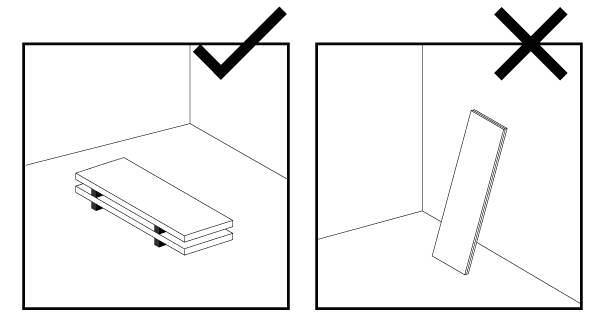
- The room humidity is stable.
- All carcases and cabinets are built and fully fitted/complete.
- All building dust and debris has been cleaned and cleared off site.
- All wet trades are finished and a sufficient period of time allowed for natural drying.
- Fresh plasterwork has been allowed to dry for a minimum of 6 weeks or until the plaster is dry throughout.
Before cutting your worktop, we advise oiling a small area of your worktops to ensure they all match. Please also thoroughly check for any imperfections or bowing that may not be suitable before cutting or altering your worktop.
Prior to placing the worktops in situ it is important that you oil ALL the edges and faces at least twice with worktop oil. Allow between 8 and 10 hours between coats.
NOTE: Cut edges and areas of end grain will soak up more oil and will consequently require extra coats.
When positioning the worktop you must allow a 4-5mm gap between all worktop edges and any adjacent walls or units (particularly between the back of the worktop and the wall). This will allow the worktop to expand and contract with the humidity of the kitchen without causing damage.
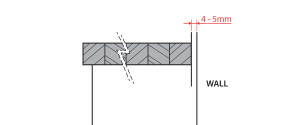
When a worktop is to be fitted near a freestanding oven (i.e. an oven that is not housed in a cabinet, such as a range cooker) allow a minimum gap of 30mm all the way around the worktop, and fit a solid wood end cap along the worktop edge. This will protect the end grain and help to prevent splitting.
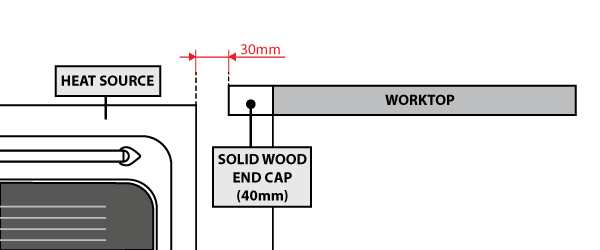
Special care must be taken when fitting a worktop over appliances or exposed brickwork. Appliances such as dishwashers, washing machines and microwaves can produce extremes of heat and humidity. If an appliance is to be installed under the worktop, make sure a moisture barrier is used to protect the underside from any possible heat or moisture. Use the same procedure for installations when you are fixing directly onto exposed brickwork.
NOTE: The maximum unsupported overhang on any worktop is 200mm. Any larger will require additional support such as Breakfast Bar Legs to support the additional weight.
When fixing worktops to the cabinets you must only use slotted angle brackets. A round head screw must be used to fix the bracket. It is important that you use the slot that runs perpendicular to the width (across and not parallel with the grain).
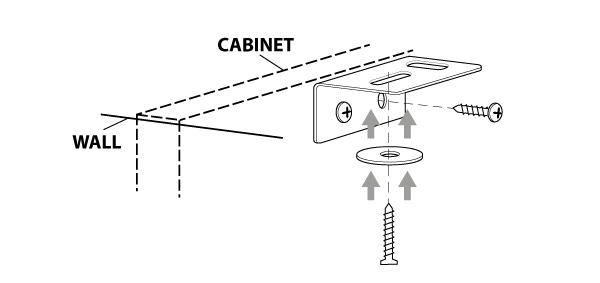
NOTE: Some cabinets are supplied with brackets that are not slotted and these must not be used.
If your cabinets have a solid top or you can only secure through the cross rail you will not be able to fit slotted brackets. In these circumstances you must drill an oversized hole (8-10mm) through the top of the carcass and secure the worktop using a larger washer and screw. This will allow the work surface to slide over the washer in case of any possible expansion or shrinkage.
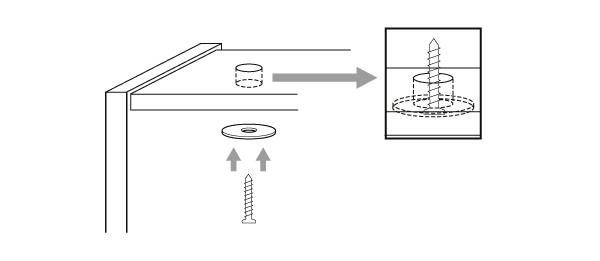
NOTE: Do not screw through the carcass directly into the worktop. Do not use fixing blocks to secure. Do not use any worktop fixing methods other than those recommended here.
We recommend that worktops are fitted with an upstand where necessary to cover the 4-5mm expansion gap. The upstand must be fixed to the wall and NOT the worktop. The upstand will cover the gap and hide any possible shrinkage that may occur.
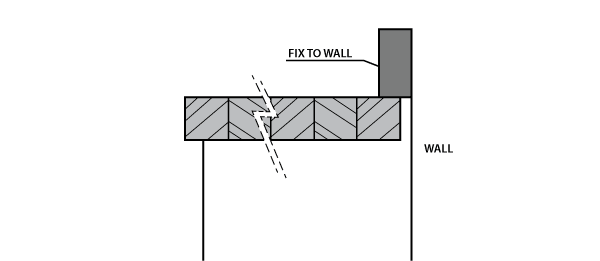
NOTE: An upstand is not required where tiling or silicone will cover the expansion gap.
Onto masonry features
Do not fix wooden tops directly into masonry. Fit them over timber spacers 6 - 10mm thick, which are on a Damp Proof Membrane (DPM). This prevents the transmission of moisture and provides airspace under the top.
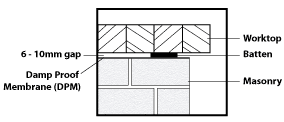
Cupped or bowed surfaces
A different installation (or in some cases re-installation) procedure is necessary should your work surface become cupped or bowed. This is unlikely but can occur as a result of incorrect/prolonged storage or moisture differences on site. If this is the case then the following instructions apply:
- 1. Fix the length of the rear of the worktop to the supporting base units.
- 2. Slowly and carefully pull the worktop downwards using clamps and battens.
- 3. Screw down the front edge of the worktop.
Please note: it may take 1-2 weeks for the worktop to completely return to its flat shape and settle down.
Where appropriate, use templates supplied with the sink/hob etc. as a guide for cutting your worktop. IMPORTANT: Before making any cuts into your worktop ensure it is marked correctly. When cutting a wooden worktop with a router cutter, this should be done in 10mm increments.
If drainer grooves are required it is essential that they are machined by an experienced installer/fitter. It is important the grooves are correctly angled towards the sink to allow any water to drain. If water does sit in the grooves, it can cause the worktop to split.
When you have fitted a sink to the worktop, seal the area with an appropriate mould resistant silicone paying special attention to the underside.
NOTE: For accuracy, quality and safety, all cut outs should be bench-cut using a jig and suitable router, never a jig saw. Our staff can advise on a comprehensive range of professional quality worktop jigs, please enquire for further information..
Having made all the cut-outs i.e. for the sink, hob etc., make sure that all cut edges are treated sufficiently and immediately with oil as previously instructed in this leaflet.
When joining two worktops together, you should use three standard worktop bolts on each joint. Seal the end grain at both sides of the joint with an appropriate sealer such as TopSeal before making the joint. Seal the joint with sealer when the parts are finally tightened.
As a rule only Butt joints should be used on wooden worktops. However, if your worktop has a radius and you do have to use a mitre joint, ensure that the "hockey stick" does not over extend the 10mm bull-nose radius.
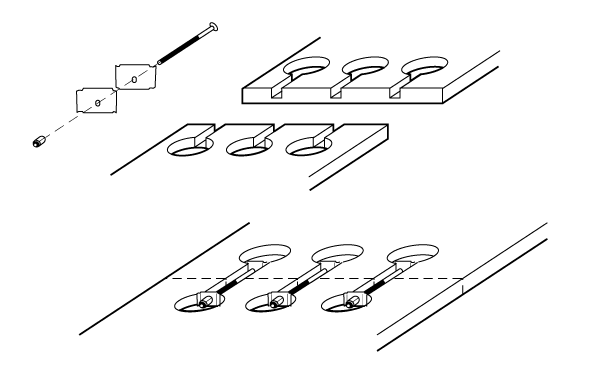
Sealing corner joints
Make sure any end grain has been sealed before assembling the joints. Apply a light bead of clear low modulus silicone sealer along one side of the joint, just below the top surfaces and edges. Align the two sides with biscuits before clamping up firmly with worktop bolts. Wipe off any surplus sealant.
Move the tops into place. Use thin pieces of board as temporary packing to position them with 4 - 5mm expansion gaps between the edges and ends of the tops and the walls.
We recommend finishing our products with Osmo Top Oil.
Make sure the wood surface is dry and clean. The face of the worktop requires 2 coats of oil to be applied to build up a barrier against water. Allow up to 8-10 hours between coats.
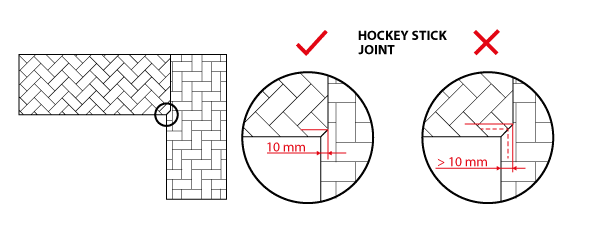
NOTE: Not oiling your worktop (pre-oiled or untreated), can lead to bowing, splitting and other issues.
NOTE: Drying times will vary subject to room temperature.
After fitting, apply two coats of Osmo Top Oil for optimal coverage, following the instructions on the tin and allowing 8-10 hours between coats. For exposed end grain, like sink cutouts, a third coat is suggested for added durability. We recommend 500ml of Osmo oil per 3 linear metres of worktop. Freshly oiled wooden surfaces typically require 2-3 weeks to fully cure and properly harden before they can be used normally so it's important to be careful with your worktop during this time.
NOTE: Failure to follow these installation instructions will result in the void of any product warranty.
Following just a few simple rules will help you get the best out of your solid wood worktop. Our recommendations are as follows:
Although durable and resistant to water ingress, we recommend mopping up any spillages as soon as possible with a clean dry cloth. This is to ensure your worktop remain hygienic and safe to use.
Wipe worktops down regularly with a damp (not wet), lint-free cloth, and warm water. We do not recommend using multi-purpose cleaning products which contain chemicals as this may damage the worktops. Please also avoid the use of scouring pads. If a scouring pad is used, the worktop may need to be re-oiled afterwards.
Do not cut directly onto the worktop. Please place a chopping board or butcher's block on top of the worktop surface for this purpose.
Avoid placing hot, wet, or dirty pots and pans directly on the worktop. To protect the surface, always use heat-resistant trivets or stainless steel hot rods. Additionally, metal containers including tin, aluminium, iron, copper, and steel can stain the timber, so direct contact should be avoided.
To maintain the fine quality of your solid wood worktop, be sure to oil regularly. Wood is a natural material and a proper course of oil treatment is essential to ensure a long and trouble-free life.
In the first few weeks of use, special care must be taken to prevent the worktops becoming stained before they have built up sufficient oil protection. In particular water must not be allowed to lie on the surface.
When the surface has a sheen, and water 'beads' or forms into droplets, you can tell that the worktop is in good condition. When the surface is dull and droplets don't form, you need to re-oil the worktop.

 65,000+ Reviews | 4.8 TrustScore
65,000+ Reviews | 4.8 TrustScore